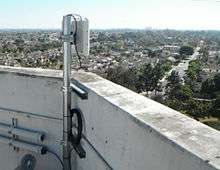Point-to-point (telecommunications)
In telecommunications, a point-to-point connection refers to a communications connection between two nodes or endpoints. An example is a telephone call, in which one telephone is connected with one other, and what is said by one caller can only be heard by the other. This is contrasted with a point-to-multipoint or broadcast connection, in which many nodes can receive information transmitted by one node. Other examples of point-to-point communications links are leased lines, microwave relay links, and two way radio.
The term is also used in computer networking and computer architecture to refer to a wire or other connection that links only two computers or circuits, as opposed to other network topologies such as buses or crossbar switches which can connect many communications devices.
Point-to-point is sometimes abbreviated as P2P. This usage of P2P is distinct from P2P referring to peer-to-peer for file sharing networks.
Basic point-to-point data link
A traditional point-to-point data link is a communications medium with exactly two endpoints and no data or packet formatting. The host computers at either end had to take full responsibility for formatting the data transmitted between them. The connection between the computer and the communications medium was generally implemented through an RS-232 or similar interface. Computers in close proximity may be connected by wires directly between their interface cards.
When connected at a distance, each endpoint would be fitted with a modem to convert analog telecommunications signals into a digital data stream. When the connection used a telecommunications provider, the connections were called a dedicated, leased, or private line. The ARPANET used leased lines to provide point-to-point data links between its packet-switching nodes, which were called Interface Message Processors.
Modern point-to-point links

In (2003), the term point-to-point telecommunications relates to fixed wireless data communications for Internet or voice over IP via radio frequencies in the multi-gigahertz range. It also includes technologies such as laser for telecommunications but in all cases expects that the transmission medium is line of sight and capable of being fairly tightly beamed from transmitter to receiver. The Telecommunications Industry Association's engineering committees develop U.S. standards for point-to-point communications and related cellular tower structures.[1] Online tools help users find if they have such line of sight.[2]
The telecommunications signal is typically bi-directional, either time division multiple access (TDMA) or channelized.
In hubs and switches, a hub provides a point-to-multipoint (or simply multipoint) circuit which divides the total bandwidth supplied by the hub among each connected client node. A switch on the other hand provides a series of point-to-point circuits, via microsegmentation, which allows each client node to have a dedicated circuit and the added advantage of having full-duplex connections.
Within many switched telecommunications systems, it is possible to establish a permanent circuit. One example might be a telephone in the lobby of a public building, which is programmed to ring only the number of a telephone dispatcher. "Nailing down" a switched connection saves the cost of running a physical circuit between the two points. The resources in such a connection can be released when no longer needed, for example, a television circuit from a parade route back to the studio.
References
- ↑ "TR-14 | Structural Standards for Communication and Small Wind Turbine Support Structures". Telecommunications Industry Association.
- ↑ "PtP Estimator Overview". AlphiMAX. Retrieved August 29, 2011.